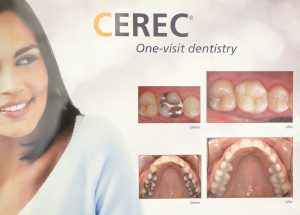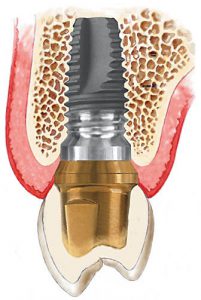Restorative Techniques & Materials
Advances in modern dental materials and techniques increasingly offer new ways to create more pleasing, natural-looking smiles. Researchers are continuing their often decades-long work developing esthetic materials, such as ceramic and plastic compounds that mimic the appearance of natural teeth. As a result, dentists and patients today have several choices when it comes to selecting materials used to repair missing, worn, damaged or decayed teeth.
The advent of these new materials has not eliminated the usefulness of more traditional dental restoratives, which include gold, base metal alloys and dental amalgam. The strength and durability of traditional dental materials continue to make them useful for situations where restored teeth must withstand extreme forces that result from chewing, such as in the back of the mouth.
What’s Right for Me?
Several factors influence the performance, durability, longevity and expense of dental restorations. These factors include: the components used in the filling material; where and how the filling is placed; the chewing load that the tooth will have to bear; and the length and number of visits needed to prepare and adjust the restored tooth.
With so many choices, how do you know what’s right for you? To help you better understand what’s available, let’s look at the advantages and disadvantages of commonly used dental restorations.
The ultimate decision about what to use is best determined by the patient in consultation with the dentist. Before your treatment begins, discuss the options with your dentist.
Composite Restorations (Fillings)
Composite fillings are a mixture of acrylic resin and finely ground glasslike particles that produce a tooth-colored restoration. Composite fillings provide good durability and resistance to fracture in small-to-mid size restorations that need to withstand moderate chewing pressure. Less tooth structure is removed when the dentist prepares the tooth, and this may result in a smaller filling than that of an amalgam. Composites are “bonded” or adhesively held in a cavity, often allowing the dentist to make a more conservative repair to the tooth.
In teeth where chewing loads are high, composite fillings are moderately resistant to wear, but less so than amalgam fillings. The cost is moderate and depends on the size of the filling and the technique used by the dentist to place it in the prepared tooth. The time required to place a composite filling is usually longer than what is required for an amalgam filling. Composite fillings require a cavity that can be kept clean and dry during filling and they are subject to stain and discoloration over time.
American Dental Association
Copyright 2002
Crowns
Indirect Restorative Dental Materials (Two or more visits)
Sometimes the best dental treatment for a tooth is to use a restoration that is made in a laboratory from a mold. These custom-made restorations, which require two or more visits, can be crowns, inlays or onlays. A crown covers the entire chewing surface and sides of the tooth. An inlay is smaller and fits within the contours of the tooth. An onlay is similar to an inlay, but it is larger and covers some or all chewing surfaces of the tooth. The cost of indirect restorations is generally higher due to the number and length of visits required, and the additional cost of having the restoration made in a dental laboratory. Materials used to fabricate these restorations are porcelain (ceramic), porcelain fused to metal, gold alloys and base metal alloys.
All-Porcelain (Ceramic) Dental Materials

CEREC – Restorations
All-porcelain (ceramic) dental materials include porcelain, ceramic or glasslike fillings and crowns. They are used as inlays, onlays, crowns and aesthetic veneers. A veneer is a very thin shell of porcelain that can replace or cover part of the enamel of the tooth. All-porcelain (ceramic) restorations are particularly desirable because their color and translucency mimic natural tooth enamel.
Dr. Martz offers a single visit CEREC RESTORATION.
Porcelain-fused-to-Metal
Another type of restoration is porcelain-fused-to-metal, which is used to provide strength to a crown or bridge. These restorations are very strong and durable.
The combination of porcelain and metal creates a stronger restoration than porcelain used alone. More of the existing tooth must be removed to accommodate the restoration. Although they are highly resistant to wear, porcelain restorations can wear opposing natural teeth if the porcelain becomes rough. There may be some initial discomfort to hot and cold. While porcelain-fused-to-metal restorations are highly biocompatible, some patients may show an allergic sensitivity to some types of metals used in the restoration.
Implants
After clinically evaluating the patient, and with a full set or radiographs, Dr. Martz will assess the oveall health of the patient’s mouth and will offer options on how to replace missing teeth. If implants are a possible option, Dr. Martz will refer the patient to an oral surgeon or periodontist to confirm that the patient is a good candidate for implants. Once the patient is determined to be a good candidate, the oral surgeon or periodontist will perform the procedure and place the implant in the bone of the jaw. Once the implant integrates in the bone Dr. Martz will restore the implant with a naturally looking crown.
What are Implants?
A dental implant is an artificial tooth root (made of titanium material) that is surgically placed into your jaw to hold a replacement tooth or bridge in place. The benefit of using implants is that they don’t rely on neighboring teeth for support, they are permanent and stable. Implants are a good solution to tooth loss because they look and feel like natural teeth.
Can anyone receive dental implants?
Talk with your dentist about whether you are an implant candidate. You must be in good health and have the proper bone structure and healthy gums for the implant to stay in place. People who are unable to wear dentures may also be good candidates. If you suffer from chronic problems, such as clenching or bruxism, or systemic diseases, such as diabetes, the success rate for implants decreases dramatically. Additionally, people who smoke or drink alcohol may not be good candidates.
What can I expect during this procedure?
The oral surgeon or periodontists must perform surgery to anchor the “artificial root” into or on your jaw bone. The procedure is done in the dental office with local anesthesia. Medications may be prescribed for pain if neccesary.
How long does the process take?
The process can take up to nine months to complete in order for the implant to osseointegrate in the jaw. Technology, however, is trying to decrease the healing time involved. Each patient heals differently, so times will vary.
What is the success rate of implants?
The success rate for implants depends on the tooth’s purpose and location in the mouth. The success rate is about 95 percent.
How do I care for implants?
Your overall health may affect the success rate of dental implants. Poor oral hygiene is a big reason why some implants fail. It is important to floss and brush around the fixtures at least twice a day, without metal objects. Your dentist will give you specific instructions on how to care for your new implants. Additional cleanings of up to four times per year may be necessary to ensure that you retain healthy gums.
What is the cost of implants?
Since implants involve surgery and are a more sophisticated treatment plan they cost more than traditional bridge work. However, some dental procedures and portions of the restoration may be covered by dental and medical insurance policies. Your dentist can help you with this process.
Introduction & Overview

- Implant systems provide an advanced therapy for replacing teeth, while giving you all of the advantages nature intended:– Improving your smile and appearance
– Allowing you to eat the foods you enjoy
– Restoring painless chewing for easy digestion
– Letting you speak with greater ease and confidence
– Returning your natural facial structure
– Enjoying an active professional and social life - This chart has been designed to help you understand dental implant therapy, the steps involved in various implant procedures, and how dental implants compare with other tooth replacement alternatives.
- In addition, this chart will explain the process of bone loss that occurs after teeth are lost and the consequences this may have for future tooth replacement.
- The illustrations represent common clinical situations. However, the actual number of implants utilized and the method of restoration may differ by individual case. The dental team will determine the best treatment plan to fit your particular needs.
- Regardless of the restorative option you discuss with your dentist, you should review the introductory and hygiene sections of this chart.
Comparing Implants To Natural Teeth
All natural teeth have a dentin core, surrounded by an enamel coating, and are anchored in the jaw bone by their roots.

Dental implants are an ideal tooth replacement therapy because implants closely mimic natural teeth.
Candidates / Effects
Who Is A Candidate For Implant Therapy?
Each year, hundreds of thousands of people all around the world benefit from dental implant therapy, from children in their early years to adults in their nineties. According to The American Academy of Periodontology, “The ideal candidate for a dental implant is in good general and oral health. Adequate bone in your jaw is needed to support the implant, and the best candidates have healthy gum tissues that are free from periodontal disease.”
Your dentist will evaluate various factors to determine if you’re a candidate for dental implants. Those factors may include certain health conditions (e.g., uncontrolled diabetes) or risk factors (e.g.,smoking). These types of conditions may not rule out dental implants, but they must be taken into consideration to be sure they will not compromise successful implant therapy.
One important factor affecting implant therapy is the density of your jaw bone, which can vary in density from very dense (ideal) to very porous or spongy. Less-than-ideal bone density does not necessarily prevent having dental implants, but it will likely affect your treatment plan.
CT scans, are available to the surgeon to determine the most predictable placement.
Frequently Asked Questions
The surgery is usually carried out as an outpatient procedure under local anaesthetic mainly with an intravenous sedative, and is generally not at all painful. When the local anaesthetic wears off some hours after the surgery, mild discomfort is normal; you will be given advice about painkillers, which will relieve this.
How long do I need to wait for my implants to bond before I get my new teeth?
Usually we must wait 3 months in the lower jaw and 4 in the upper before we can begin to construct the new teeth. In a some cases it may be possible to shorten this period.
Do implants ever fail?
Implants have a successful rate of over 97%. (Smokers have a higher failure rate). If an implant should fail then it can often be replaced. Sometimes when several implants are placed and one fails, it is possible to proceed with the original treatment plan and replace the missing teeth without needing to replace the failed implant.
Is bone grafting is sometimes necessary?
Sometimes the implant surgeon needs to build up the bone in the implant area. (Bone often dissolves away following tooth loss). Sometimes the surgeon is able to bend or stretch the bone to allow implant placement, or artificial bone substitute can be used. Very occasionally bone needs to be taken from a different area of the patient as a graft. Commonly this is from a different part of the jawbone. In a small minority of patients the bone grafting procedure is more involved, your surgeon will of course explain this to you.